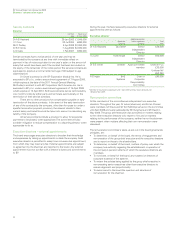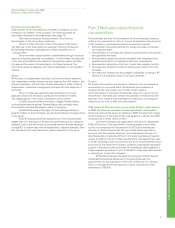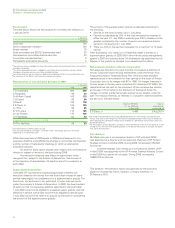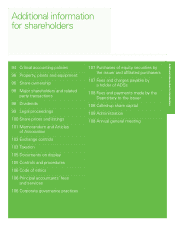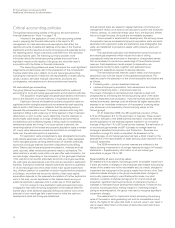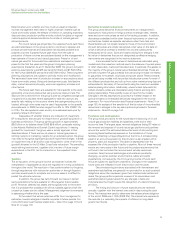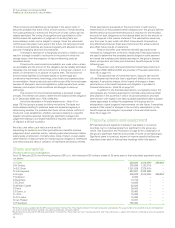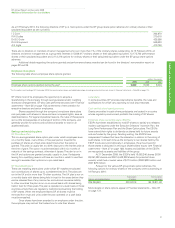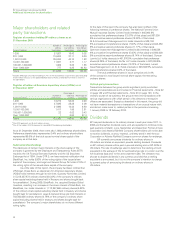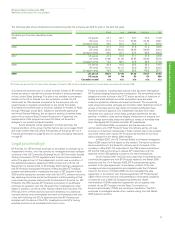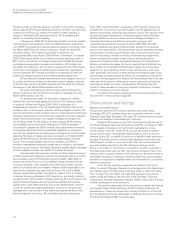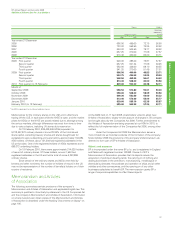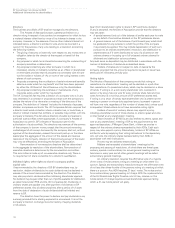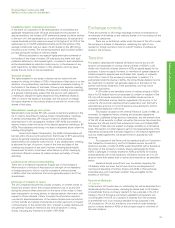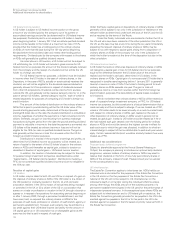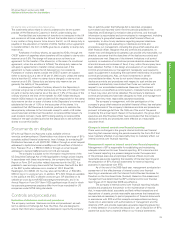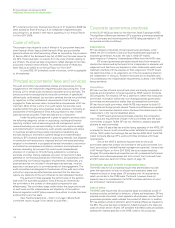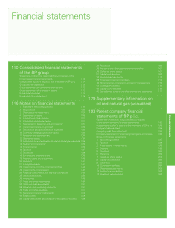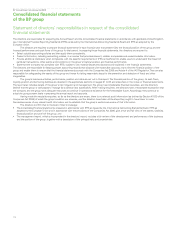BP 2009 Annual Report Download - page 102
Download and view the complete annual report
Please find page 102 of the 2009 BP annual report below. You can navigate through the pages in the report by either clicking on the pages listed below, or by using the keyword search tool below to find specific information within the annual report.
100
BP Annual Report and Accounts 2009
Additional information for shareholders
The Texas Office of Attorney General, on behalf of the TCEQ, has filed a
petition against BP Products asserting certain air emission and reporting
violations at the Texas City refinery from 2005 to 2009, including in
relation to the March 2005 explosion and fire. BP is contesting the
petition in a pending civil proceeding.
In September 2009, BP Products filed a petition to clarify specific
required actions and deadlines under the 2005 Settlement Agreement
with OSHA. That agreement resolved citations issued in connection with
the March 2005 Texas City refinery explosion. OSHA has denied BP
Products’ petition. This matter is scheduled for review by the
Occupational Safety and Health (OSH) Review Commission. In October
2009 OSHA issued the Texas City Refinery citations seeking a total of
$87.4 million civil penalty for alleged violations of the 2005 Agreement
and alleged process safety management violations. BP Products has
contested the citations so this will also be reviewed by the OSH Review
Commission and possibly the federal courts. Settlement negotiations
continue between BP Products and OSHA in an attempt to settle the
citations for alleged violations of the 2005 settlement agreement.
BP has received a shareholder derivative action against various of
its current and former officers and directors based on alleged violations
of the US Clean Air Act and OSHA regulations at the Texas City refinery
subsequent to the March 2005 explosion and fire.
BP is also defending civil personal injury claims by Texas City
refinery workers or their families from incidents or releases since the
March 2005 explosion and fire.
On 29 November 2007, BP Exploration (Alaska) Inc. (BPXA)
entered into a criminal plea agreement with the DOJ relating to leaks
of crude oil in March and August 2006. BPXA’s guilty plea, to a
misdemeanour violation of the US Federal Water Pollution Control Act,
included a term of three years’ probation. BPXA is eligible to petition the
court for termination of the probation term if it meets certain benchmarks
relating to replacement of the transit lines, upgrades to its leak detection
system and improvements to its integrity management programme.
On 31 March 2009, the DOJ filed a complaint against BPXA seeking
civil penalties and injunctive relief relating to the 2006 oil releases.
The complaint alleges that BPXA violated various federal environmental
and pipeline safety statutes and associated regulations in connection
with the two releases and its maintenance and operation of North Slope
pipelines. The State of Alaska also filed a complaint on 31 March 2009
against BPXA seeking civil penalties and damages relating to these
events. The complaint alleges that the two releases and BPXA’s
corrosion management practices violated various statutory, contractual
and common law duties to the State, resulting in penalty liability, damages
for lost royalties and taxes, and liability for punitive damages.
Approximately 200 lawsuits were filed in state and federal courts
in Alaska seeking compensatory and punitive damages arising out of the
Exxon Valdez oil spill in Prince William Sound in March 1989. Most of
those suits named Exxon (now ExxonMobil), Alyeska Pipeline Service
Company (Alyeska), which operates the oil terminal at Valdez, and the
other oil companies that own Alyeska. Alyeska initially responded to the
spill until the response was taken over by Exxon. BP owns a 46.9%
interest (reduced during 2001 from 50% by a sale of 3.1% to Phillips)
in Alyeska through a subsidiary of BP America Inc. and briefly indirectly
owned a further 20% interest in Alyeska following BP’s combination with
Atlantic Richfield. Alyeska and its owners have settled all the claims
against them under these lawsuits. Exxon has indicated that it may file
a claim for contribution against Alyeska for a portion of the costs and
damages that it has incurred. If any claims are asserted by Exxon that
affect Alyeska and its owners, BP will defend the claims vigorously.
Since 1987, Atlantic Richfield, a subsidiary of BP, has been named as a
co-defendant in numerous lawsuits brought in the US alleging injury to
persons and property caused by lead pigment in paint. The majority of the
lawsuits have been abandoned or dismissed against Atlantic Richfield.
Atlantic Richfield is named in these lawsuits as alleged successor to
International Smelting and Refining and another company that
manufactured lead pigment during the period 1920-1946. Plaintiffs
include individuals and governmental entities. Several of the lawsuits
purport to be class actions. The lawsuits seek various remedies including
compensation to lead-poisoned children, cost to find and remove lead
paint from buildings, medical monitoring and screening programmes,
public warning and education of lead hazards, reimbursement of
government healthcare costs and special education for lead-poisoned
citizens and punitive damages. No lawsuit against Atlantic Richfield has
been settled nor has Atlantic Richfield been subject to a final adverse
judgement in any proceeding. The amounts claimed and, if such suits
were successful, the costs of implementing the remedies sought in the
various cases could be substantial. While it is not possible to predict the
outcome of these legal actions, Atlantic Richfield believes that it has valid
defences and it intends to defend such actions vigorously and that the
incurrence of liability is remote. Consequently, BP believes that the
impact of these lawsuits on the group’s results of operations, financial
position or liquidity will not be material.
For certain information regarding environmental proceedings, see
Environment – United States on page 48.
Share prices and listings
Markets and market prices
The primary market for BP’s ordinary shares is the London Stock
Exchange (LSE). BP’s ordinary shares are a constituent element of the
Financial Times Stock Exchange 100 Index. BP’s ordinary shares are also
traded on the Frankfurt stock exchange in Germany.
Trading of BP’s shares on the LSE is primarily through the use of
the Stock Exchange Electronic Trading Service (SETS), introduced in 1997
for the largest companies in terms of market capitalization whose
primary listing is the LSE. Under SETS, buy and sell orders at specific
prices may be sent to the exchange electronically by any firm that is a
member of the LSE, on behalf of a client or on behalf of itself acting as a
principal. The orders are then anonymously displayed in the order book.
When there is a match on a buy and a sell order, the trade is executed
and automatically reported to the LSE. Trading is continuous from
8.00 a.m. to 4.30 p.m. UK time but, in the event of a 20% movement in
the share price either way, the LSE may impose a temporary halt in the
trading of that company’s shares in the order book to allow the market to
re-establish equilibrium. Dealings in ordinary shares may also take place
between an investor and a market-maker, via a member firm, outside the
electronic order book.
In the US, the company’s securities are traded in the form of
ADSs, for which JPMorgan Chase Bank is the depositary (the Depositary)
and transfer agent. The Depositary’s principal office is 4 New York Plaza,
Floor 13, New York, NY 10004, US. Each ADS represents six ordinary
shares. ADSs are listed on the New York Stock Exchange. ADSs are
evidenced by American depositary receipts (ADRs), which may be issued
in either certificated or book entry form.
The following table sets forth for the periods indicated the highest
and lowest middle market quotations for BP’s ordinary shares for the
periods shown. These are derived from the Daily Official List of the LSE
and the highest and lowest sales prices of ADSs as reported on the New
York Stock Exchange (NYSE) composite tape.


